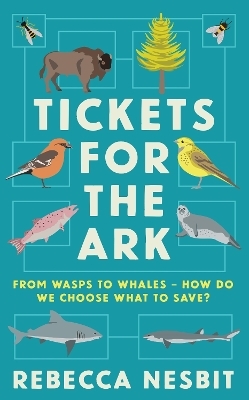
Tickets for the Ark
From wasps to whales – how do we choose what to save?
Seiten
2024
|
Main
Profile Books Ltd (Verlag)
978-1-78816-709-3 (ISBN)
Profile Books Ltd (Verlag)
978-1-78816-709-3 (ISBN)
'Thought-provoking ... a welcome antidote to the simplistic and divisive thinking that can sometimes taint the well-meaning world of conservation.' Katie Burton, Geographical
Our planet hasn't seen the current rate of extinction since the demise of the dinosaurs 65 million years ago, and global conservation efforts are failing to halt this. As a society, we face choices which will determine the fate of Earth's estimated 8.7 million species, including humans. As wildlife declines, conservation needs to make trade-offs. But what should we conserve and why?
Are we wrong to love bees and hate wasps?
Are native species more valuable than newcomers (aka invasives)?
Should some animals be culled to protect others, or for our own economic interests?
What do we want the 'natural world' to look like, and how can we shape a world in which wildlife and people can thrive?
Our planet hasn't seen the current rate of extinction since the demise of the dinosaurs 65 million years ago, and global conservation efforts are failing to halt this. As a society, we face choices which will determine the fate of Earth's estimated 8.7 million species, including humans. As wildlife declines, conservation needs to make trade-offs. But what should we conserve and why?
Are we wrong to love bees and hate wasps?
Are native species more valuable than newcomers (aka invasives)?
Should some animals be culled to protect others, or for our own economic interests?
What do we want the 'natural world' to look like, and how can we shape a world in which wildlife and people can thrive?
Rebecca Nesbit is an ecologist and author, writing on science and the ethical questions it raises, in particular in relation to conservation. She is the author of Is that Fish in your Tomato?, which explored the benefits and the risks of genetically modified foods. After graduating from Durham University, she worked in scientific research, chiefly on butterfly migrations, before working on a program training honeybees to detect explosives. She has worked for the Royal Society of Biology and Nobel, and is a contributor to Scientific American, The Biologist and Popular Science.
| Erscheint lt. Verlag | 1.2.2024 |
|---|---|
| Verlagsort | London |
| Sprache | englisch |
| Maße | 129 x 198 mm |
| Themenwelt | Naturwissenschaften ► Biologie ► Ökologie / Naturschutz |
| Naturwissenschaften ► Biologie ► Zoologie | |
| ISBN-10 | 1-78816-709-0 / 1788167090 |
| ISBN-13 | 978-1-78816-709-3 / 9781788167093 |
| Zustand | Neuware |
| Haben Sie eine Frage zum Produkt? |
Mehr entdecken
aus dem Bereich
aus dem Bereich


